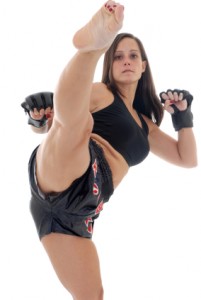 Muay Thai, the “Art of Eight Limbs,” is one of the deadliest forms of martial arts. It’s called the Art of Eight Limbs because it incorporates striking with hands, elbows, knees and shins to knock your opponent out or strike them into submission. Boxing, for instance, uses two points of contact (both hands) and many other forms of martial arts use only hands and feet.
Muay Thai, the “Art of Eight Limbs,” is one of the deadliest forms of martial arts. It’s called the Art of Eight Limbs because it incorporates striking with hands, elbows, knees and shins to knock your opponent out or strike them into submission. Boxing, for instance, uses two points of contact (both hands) and many other forms of martial arts use only hands and feet.
Muay Thai was developed in Southeast Asia, but it has spread across the world with the popularity of mixed martial arts on television. Muay Thai is the stand up base for MMA fighting. It was once called the martial art of the kings because of the fact that in 1914 the sons of King Sen Muajng Ma fought until their death for the throne of their father.
Muay Thai has a heavy focus on body conditioning, designed to promote a high level of fitness necessary for endurance in the ring. In fact, the most important aspect in training in Muay Thai is extensive endurance. Cardio, strength, muscle gain and definition, plus fat loss are crucial to a fighter’s survival. Training regimens include running, shadowboxing, jump rope, medicine ball, weight training, and exercises to strengthen different areas of the body, including abdominals.
The punches involved include the jab, cross, hook, uppercut, and wide hooks. The elbows include the up elbow, down elbow, horizontal elbow, and spinning back elbow. The knees most often utilized are the clinch knee, curve knee and flying knee, and the kicks include the right and left straight kicks and foot jabs.
Muay Thai classes typically involve several different training methods. Most often, a class will start with an extensive warm up, comprised of jump rope, short run drills and shadowboxing. Then the instructor may move on to heavy bag work or pad rounds, which adds in the interactivity of a partner and can be very intense. Often sparring will follow – a training method that is the closest you will come to an actual fight. Sparring applies your fighting techniques at 50-80 percent while wearing protective gear.
The class will often include conditioning work, including medicine ball work such as squats, wall ball tosses and ball slams. Even if you never desire to be a professional fighter, the aspects of Muay Thai training can be used to lose weight, get fit or gain confidence. Thanks to the extensive cardio and endurance work, Muay Thai fighters are very strong and solid.
- Find a reputable school. Observe a class to see if you like the teacher’s instructing style. A good school will allow you to train a few classes on a trial basis.
- Begin well-hydrated. You will sweat more than you think possible!
- Wear your protective gear as instructed by your teacher. Mouth guards, 16-ounce gloves, hand wraps and shin guards are all necessary.
- Be sure to warm up slowly and thoroughly.
- Stretching is important.
- Follow your class with proper nutrition – smoothies are a great source of protein and carbs to replenish.
(image: ExplorerGirls.com)
Also read:
